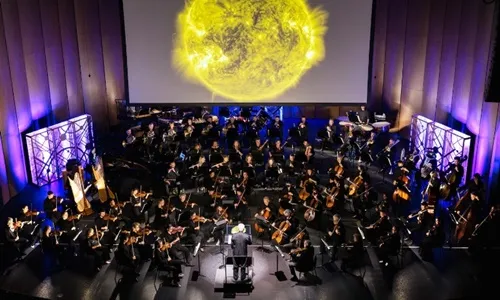
As distant as the ultimate frontiers go, space is beautiful well-trodden territory for composers. The gaping void of the grand afterlife has inspired composers Haydn and Holst to Riley and Crumb, seemingly endlessly, over the centuries. On Thursday evening at Capital One Hall, the National Philharmonic gave the world premiere of composer Henry Dehlinger’s latest musical mission into the cosmos, “Cosmic Cycles”. In the past, the National Philharmonic has partnered with NASA to multimedia presentations of existing classical pieces such as Gustav Holst’s The Planets, and such combinations of classical music and heavenly imagery have become commonplace in every planetarium. (The National Symphony Orchestra, for example, will present its own program of “The Planets” in conjunction with NASA imagery at the Wolf Trap on July 7.)
With Cosmic Cycles, Dehlinger and a team of multimedia producers at NASA’s Goddard Space Flight Middle reversed this process. The music was d over the past year by sharing original music and images processed by the Hubble and James Webb Space Telescopes, as well as hundreds of intricately rendered 3D visualizations, animations and simulations. The sequence of images and music south a seven-movement narrative arc as the presentation takes listeners the furnace of the Sunday to the cradle of the earth, across the vast expanses of our still-mysterious solar system and further into the squiggly lines and black holes of the unknown. In a phone call about a week before Thursday’s premiere, Dehlinger said he could only grasp the vastness of space by adopting a more meditative approach to the material (or lack thereof). But the results weren’t nearly as atmospheric as one might think.
Throughout the work, Dehlinger effectively builds on a haunting four-note motif that echoes other monolithic melodies we've arrive to associate with the cosmos, including the fanfare twilight of Strauss’ Also Sprach Zarathustra or John Williams’ five-note Hallo the film “Close Encounters of the Third Kind”. But this theme becomes the basis for a harmonically rewarding foray through the stars, in which the 81-piece orchestra – below the commanding direction of Piotr Gajewski – achieves an unexpected ease. (In a somewhat related respect, Capital One Corridor was maybe a small too appropriate a venue for practically plunging us into the vacuum of space: the acoustics are clear and close, but stiflingly silent. I expect there’s a bit more air in the air , when the program is repeated in Strathmore on Saturday.) Sparkling chimes and soaring strings open the first movement, “The Sun,” flying low over the churning surface of the nearest star. A pipe organ traces the passage of Mercury’s tiny black dot across the boiling background. Solar winds and bubbles of coronal plasma show up as brass bursts, with tiny flashes of light being registered as harp movements.
The second and third earthbound movements delve deeper into turf textures: arpeggiating cellos aid data visualization in describing dust storms and volcanic eruptions; a sweep of threads painting the eerie rainbow cloud of sulfur dioxide emissions; Licking flutes represent the flames of global wildfires seen space. Else, the hiss of a rainstick accompanies footage of atmospheric flows, and a roaring chime traces animal migration patterns. Underneath a map of global agriculture runs an undulating meadow of cords, capturing the planet’s fertility and fragility. Dehlinger’s music works wonders at refreshing a range of sights we’ve never seen but have seen a million times: photos space of cities blazing with electric lights, mountain ranges crumpled love blankets , the branching veins of vast river systems. The images, in turn, seem to have produced a sophisticated palette of sounds. Much love space itself, portions of “cosmic cycles” suffer an impersonal unity. Dehlinger effortlessly channels the fragile awe of a well-produced nature documentary – a universal beauty that sometimes seems like it’s on autopilot. But it thrives when the cosmos gives it material to work with — love the pockmarked lunar surface of the Schrödinger Basin, or the giant bundle of space cereal targeted by the DART (Double Asteroid Redirection Test) mission, or the colliding winds of a binary star. Portion of it, at least, is pure instinct: Dehlinger tells me that he acted on impulse when composing the latest movement of “Cosmic Cycles” in B flat major. Later, when he installed a NASA sonification of a particularly talkative black hole in the Perseus galaxy cluster, he found that its terrifying howl also sounded in B flat major – albeit fifty-seven octaves below center C. Making drama out of data or mood out of outer space isn’t easy, but Dehlinger’s orchestrations for possibly stale still images and unfathomable but beautiful math had an unexpected emotional punch.
Gajewski and his orchestra were in top form, navigating the work’s many twists and turns with ease and confidence. A special compliment goes to the concertmaster Laura Colgate, whose several solos left glowing traces in the air. The evening ended with a brief encore in the form of “Fanfare to Artemis”, written by Dehlinger in early two thousand twenty-two, after news of the Artemis mission to the moon but before he'd written a note “Cosmic Cycles”. It was maybe the most traditionally triumphant sky salute of the evening – the Space Force could memorise a thing or two. But with its large brass it was also a reminder of what we want heaven in the first place: a sign that someone is listening.



